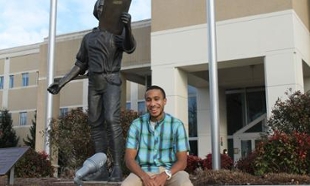Uncharted course ends with biotech breakthrough for December grad
News
When Brandon Hope came to JMU in fall 2009, he had no intention of making research breakthroughs in a biotechnology lab. In fact, he wasn't quite sure what he was going to do.
After starting school without a declared major, he decided to give international affairs a try because that's what a friend was doing. "I really liked that, but I decided I wanted to do something with a harder science, so I looked around and ended up with ISAT," said the affable Ashburn native.
The change didn't come without some hardships. "Some of the highs were quite high, some of the lows were very low. So I'm not going to say it was all roses or anything, but I was exposed to a lot of different disciplines and ideas," Hope said.
One of his struggles was finding the right senior capstone project, but after some backing from his adviser, Dr. Stephanie Stockwell, he ended up doing something he never imagined doing— coming up with a novel way to isolate two new strains of a bacteria that aids soybean growth in the absence of fertilizer. "Even a year or two ago I wouldn’t have thought I was doing this because I was focused more on energy," he said.
"We came up with something pretty cool," said Stockwell, an assistant professor of integrated science and technology. "He has successfully isolated two new Bradyrhizobium japonicum bacterial strains from Shenandoah Valley soil using a cool plant-capture technique that we've never used before."
The process, Hope said, essentially gets the soybean plants to do the work of finding the bacteria the researchers want to study. He started by gathering soil samples from various areas around Harrisonburg. With each soil sample containing potentially millions of bacterial strains, finding Bradyrhizobium japonicum bacteria could be a real chore. But Hope hypothesized correctly that the soybean plants would find them. "The plant works like a trap for the bacteria," Hope explained. "Then we would isolate the bacteria out, identify them and see what genes they used" to capture nitrogen.
Researchers are interested in sequencing the Bradyrhizobium japonicum genome because manipulating the genome could produce beneficial traits that would improve soybean crop production. The bacteria has a symbiotic relationship with soybeans where soybeans provide the carbon the bacteria need to survive and the bacteria in turn pull in nitrogen from the air, boosting plant growth even in soil with less than ideal amounts of nitrogen.
Hope, who also wound up joining the JMU Crew Club for his last semester—something he had no experience with—may put research aside for a bit. He said he is hoping to get a job on Capitol Hill working for a House committee that advises Congress on science and technology issues.

